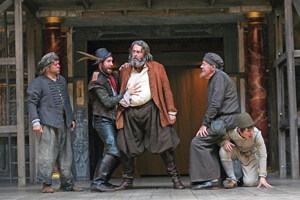With no public subsidy and a theatre programme that only lasts as long as British summertime, Shakespeare’s Globe manages to thrive. Peter Kyle explains how

Shakespeare’s Globe’s overarching mission is to further the enjoyment and understanding of Shakespeare in performance. The Globe can claim a special status because it is a faithful reconstruction of the world’s most famous theatre, which makes it an object of interest in and of itself, quite apart from the multifarious activities that take place here. It is also different because at its core – and not, as in most theatres, at its periphery – there operates a very large and wide-ranging educational programme, which operates all year round and becomes the focus of our activities when the theatre itself is ‘dark’. The architecture of the Globe also creates an atmosphere unlike any other theatre. In short, it’s great fun.
EVERYONE PLAYS A PART
We employ around 100 full and part-time staff year-round (125 in the spring and summer months), some 60 freelance staff throughout the year (largely comprising a pool of theatre professionals who teach in the education department), and approximately 180 actors, musicians and other theatre professionals during the theatre season. We also draw on around 550 volunteers – most of these in the form of theatre stewards. Shakespeare’s Globe is very much reliant upon its volunteers, without whom it could hardly function during the performance season.
Comment is often made – with some incredulity – that Shakespeare’s Globe operates entirely without public subsidy, a fact of which we are very proud. It is true that back in 1995 we were one of the earliest recipients of a grant from the Arts Council England Lottery fund, which was spent on completing the Globe itself (at that time a timber shell) and some ancillary buildings. To some, the concept that the Globe would be operationally self-financing looked like a very risky policy. Was a large open-air theatre, only able to offer a programme from (at the most) April to October, throughout notoriously unreliable British summers, really a sound financial proposition? The response was to include within the development an enormous financial insurance policy in the form of an exhibition devoted to Shakespeare and the theatre in which he worked. The revenue created by guided tours of the theatre, visits to the exhibition and its shop, it was thought, would underwrite any shortfall in ticket receipts in the theatre itself. It was a wise and far-sighted idea. The irony is that the theatre performances proved far more popular than many people – including many immediately involved in the project – ever expected. The productions have not yet been internally subsidised by the exhibition. Exhibition sales contribute instead towards the year-round running of the project.
A WELL-ROUNDED MODEL
On top of this model of theatre, exhibition and education, the Globe receives regular income from a range of other sources, including catering, corporate hospitality and venue hire, publishing, and UK and overseas touring productions. Balancing these various, often very different, interests has been and continues to be one of the chief challenges in managing the Globe. The surplus they generate is ploughed into the considerable maintenance costs of the theatre and our capital development projects. Given this broad spectrum of activities and the many constituencies to which they appeal – including London and South East residents, domestic and overseas visitors, education users and academics – our overall marketing objective is to position ourselves as the first point of reference for the appreciation and understanding of Shakespeare in performance. We do this by representing ourselves as a working theatre of good value (it is still possible for 600 members of the audience to see a play at the Globe for £5), as a major provider of educational resources at all levels, and as offering an entertaining and accessible exhibition and theatre tour.
We also receive funding (chiefly for our education programmes) from a collection of generous private individuals, public companies, trusts and foundations and a 6,000-strong membership organisation (the Friends of Shakespeare’s Globe). Many of these supporters have also contributed to our Second Stage appeal, devoted to further developing the project as originally conceived by our founder, Sam Wanamaker.
VAULTING AMBITION
This brings me to a consideration of our chief drawback: it could be argued, perversely in my view, that Shakespeare’s Globe has been a victim of its own success, and that the popularity of its work has held back capital development. How much more difficult it has been – when everything seems to be going swimmingly – to demonstrate that the Globe project is neither cash-rich nor complete. How much easier it might have been to cut back or contain artistic or educational programmes if they had been less popular or ambitious, and instead concentrate energies and resources on steadfastly completing the second, indoor, theatre corresponding to Shakespeare’s own Blackfriars playhouse, the education centre and rehearsal studio, and the purpose-built library and archive. Completing the project as originally conceived has so far been almost as great a challenge as building the Globe itself – although, thankfully, we are now nearing the completion of the first phase of our Second Stage, a suite of education and rehearsal facilities. First and foremost, however, must be the continuing pleasure and enlightenment Shakespeare’s Globe has delivered since it first opened its doors in 1996.
Peter Kyle is currently Chief Executive of Shakespeare’s Globe. He will be succeeded in October by Neil Constable.
W http://www.shakespeares-globe.org



